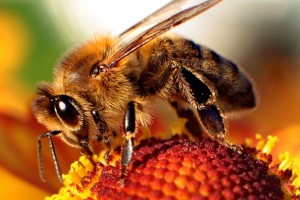NPR helps us continue our bee coverage. Today they summarize these two studies on wild bees and pollination. The first study examines the importance of wild bees in pollinating crops. Wild bees are thought to be better pollinators than honey bees and to help boost crop harvests:
Farmers who grow these crops often rely on honeybees to do the job. But scientists are now reporting that honeybees, while convenient, are not necessarily the best pollinators.
A huge collaboration of bee researchers, from more than a dozen countries, looked at how pollination happens in dozens of different crops, including strawberries, coffee, buckwheat, cherries and watermelons. As they report in the journal Science, even when beekeepers installed plenty of hives in a field, yields usually got a boost when wild, native insects, such as bumblebees or carpenter bees, also showed up.
“The surprising message in all of this is that honeybees cannot carry the load. Honeybees need help from their cousins and relatives, the other wild bees,” says Marla Spivak, a professor of entomology at the University of Minnesota. “So let’s do something to promote it, so that we can keep honeybees healthy and our wild bee populations healthy.”
The second study brings the not so good news that wild bee species might be in decline. From NPR again:
Robertson taught biology and Greek at Blackburn College in Carlinville, Ill., and he was fascinated by the close connection between insects and flowers. He spent years in the forests around Carlinville, carefully noting which insects visited which wild flowers at what time of year.
Burkle and Tiffany Knight, a colleague at Washington University in St. Louis, went back to Carlinville to see how much of the ecosystem that Robertson observed still exists today.
Much of the forested area around the town has been converted into fields of corn and soybeans — or suburbs. In the fragments of forest that remain, Burkle and Knight found all of the flowering plants that Robertson recorded in his notes a century ago. Of the 109 species of bees that Robertson saw, though, just over half seemed to have disappeared from that area.
If you have time you can listen to the NPR story here. Or check out the research papers here and here.

Comments are closed.